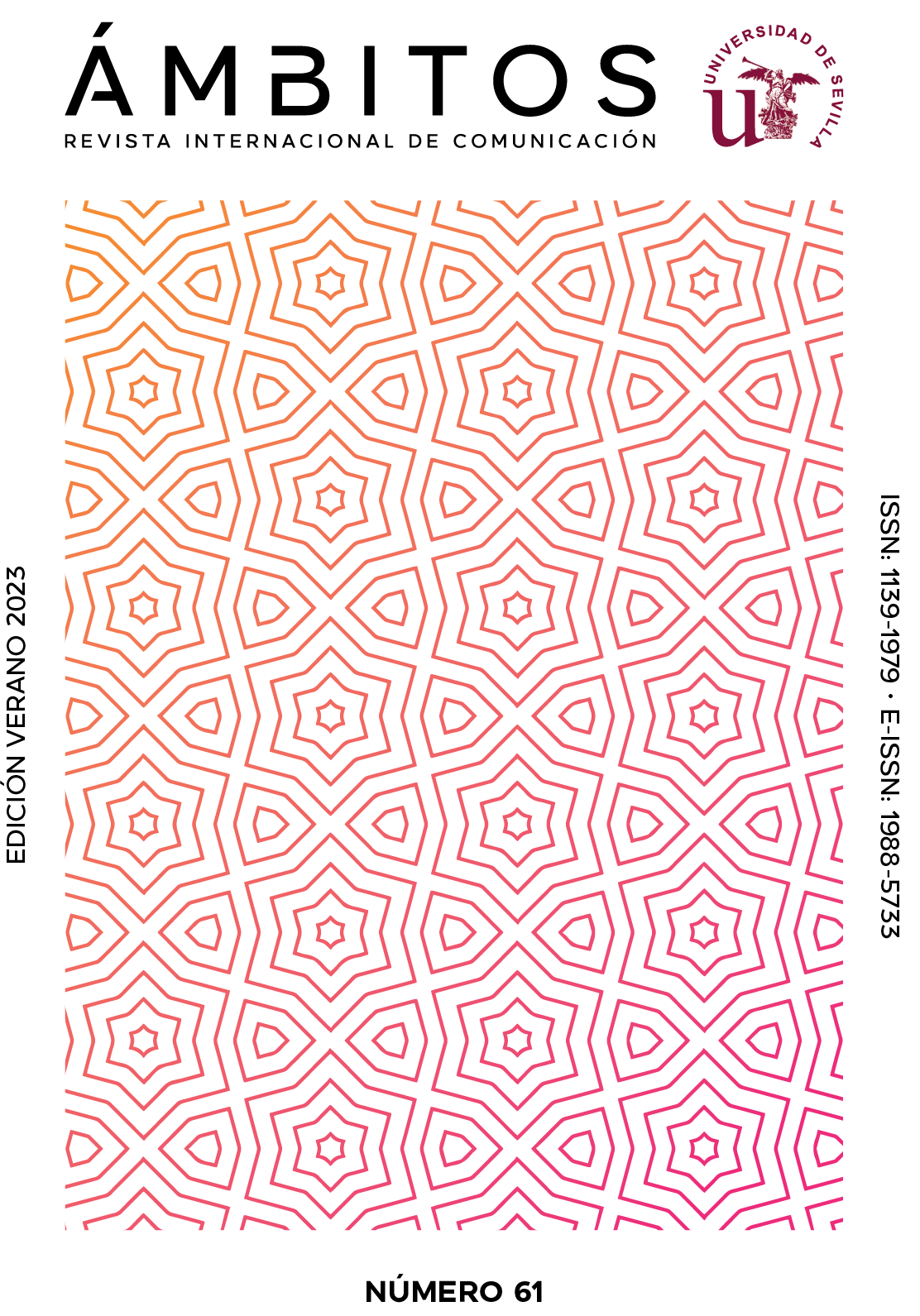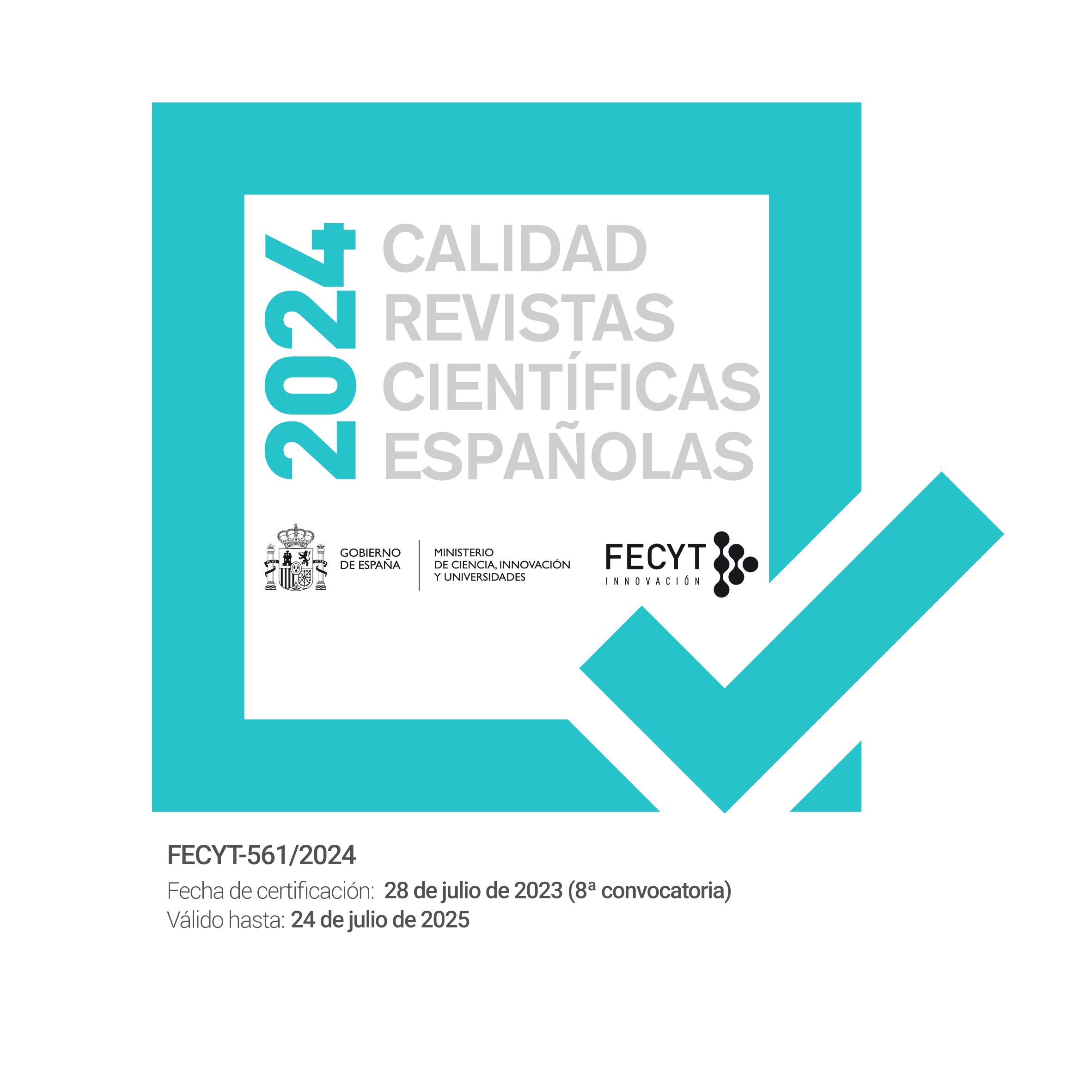Política y YouTube: análisis musivisual de las campañas electorales del 28‑A y 10‑N de 2019 en España
DOI:
https://doi.org/10.12795/Ambitos.2023.i61.02Palabras clave:
comunicación política, YouTube, imagen, música, elecciones generales de 2019Resumen
Durante 2019 en España se dan cita dos convocatorias de Elecciones Generales, una el 28 de abril y otra el 10 de noviembre, donde las distintas formaciones políticas que se presentan a ambos comicios producen un considerable número de spots electorales en YouTube. Por lo tanto, los objetivos en los que se enmarca este estudio son el de identificar, analizar y comparar los elementos musivisuales que tienen lugar en citados archivos audiovisuales con la intención de conocer la manera en la que las múltiples formaciones políticas hacen uso de las diferentes propuestas y formas de comunicación sonoras en YouTube para la difusión del mensaje electoral. Para ello, se ha propuesto un método de análisis musivisual de carácter cualitativo y cuantitativo que profundiza en los elementos musicales empleados para acompañar a la secuencia visual de los spots. Así, mediante este análisis se obtienen una serie de resultados que evidencian cómo citadas formaciones hacen un uso específico y común de algunos parámetros musicales y sonoros, tales como la música preexistente y de procedencia extradiegética, entre otras cuestiones. De manera que este estudio nos ha permitido concluir que las formaciones políticas recurren a la música como una de las principales piezas persuasivas en los spots emitidos en YouTube.
Descargas
Citas
Alaminos‑Fernández, A. F. (2016). Música en campaña. El activismo de las celebridades internacionales en causas sociales y solidarias. Limencop. https://onx.la/3ea98
Alaminos‑Fernández, A. F. (2021). La música popular en las elecciones generales de 2019 en España. Doxa Comunicación, (32), 225–249. https://doi.org/10.31921/doxacom.n32a11
Arafa, M., & Armstrong, C. (2015). Facebook to Mobilize, Twitter to Coordinate Protests, and YouTube to Tell the World: New Media, Cyberactivism, and the Arab Spring. Journal of Global Initiatives, 10(1), 73–102. https://onx.la/1d403
Aslam, S. (2018). YouTube by the numbers: Stats, de‑mographics & fun facts. Omnicore Agency.
Calvo, E. (2018). Comunicación política: caja de herramientas. Catarata.
Casero‑Ripollés, A. (2018). Investigación sobre información política y redes sociales: Puntos clave y retos de futuro. El Profesional de la Información, 27(5), 964–974. https://doi.org/10.3145/epi.2018.sep.01
Chion, M. (2017). La audiovisión. Sonido e imagen en el cine. La marca editora.
Ciudadanos. (2019a, 19 de abril). ¡Vamos, familias! [Vídeo]. YouTube. https://onx.la/1d872
Ciudadanos. (2019b, 29 de octubre). Lazos [Vídeo]. YouTube. https://cutt.ly/tN7EzGz
Darias de las Heras, V. (2018). La música y los medios de comunicación. Dykinson, S.L.
El País. (2019). Resultados de las elecciones generales del 2019 el 10 de noviembre. El País. https://onx.la/315a6
González‑Neira, A., Berrocal‑Gonzalo, S., & Zamora‑Martínez, P. (2020). Fórmulas de emisión y consumo de los debates televisivos en España en las elecciones legislativas de 2019. El Profesional de la Información, 29(2), 1–13. https://doi.org/10.3145/epi.2020.mar.21
Lagares, N., López‑López, P. C., Gulías, E. J., & Rivera, J. M. (2021). La comunidad digital y el uso político de las redes sociales: Elecciones generales del año 2019 en España. Araucaria. Revista Iberoamericana de Filosofía, Política, Humanidades y Relaciones Internacionales, (48), 235–273. https://doi.org/10.12795/araucaria.2021.i48.11
Lagares, N., Maneiro, E., & González, S. (2020). Consumo de Medios de Comunicación y Redes Sociales: Perfil de los votantes en las Elecciones Generales de España de noviembre de 2019. Risti. Revista Ibérica de Sistemas e Tecnologias de Informação, (35), 546‑558. https://onx.la/5e108
López, G., Gamir, J., & Valera, L. (2018). Comunicación política. Síntesis.
Nieto, J. (2003). Música para la imagen. La influencia secreta. SGAE.
PACMA. (2019a, 11 de abril). ¡Empieza la ReEvolución! [Vídeo]. YouTube. https://onx.la/bd34f
PACMA. (2019b, 1 de noviembre). ¡Somos la ReEvolución! [Vídeo]. YouTube. https://onx.la/d161d
Partido Popular. (2019a, 1 de noviembre). Horizontes. Por todo lo que nos une [Vídeo]. YouTube. https://onx.la/ded69
Partido Popular. (2019b, 12 de abril). Valor seguro [Vídeo]. YouTube. https://onx.la/d9135
PSOE. (2019a, 1 de noviembre). Ahora sí, vota PSOE [Vídeo]. YouTube. https://onx.la/fbe82
PSOE. (2019b, 12 de abril). Haz que pase, vota PSOE [Vídeo]. YouTube. https://onx.la/34406
Rodríguez‑Breijo, V., Gallardo‑Camacho, J., & Sierra‑Sánchez, J. (2018). Información política en los vídeos que son tendencia en YouTube España. El Profesional de la Información, 27(5), 1041–1049. https://doi.org/10.3145/epi.2018.sep.08
Rodríguez‑López, J., & Sedeño‑Valdellós, A. (2017). El videoclip y la comunicación socio‑política: El mensaje reivindicativo en el vídeo musical. Vivat Academia. Revista de Comunicación, (138), 1–15. https://doi.org/10.15178/va.2017.0.1‑15
Rodríguez, R. (2021). Cómo crear música publicitaria. Berenice.
Román, A. (2008). El lenguaje musivisual. Semiótica y estética de la música cinematográfica. Visión Libros.
Román, A. (2017). Análisis musivisual. Guía de audición y estudio de la música cinematográfica. Visión Libros.
Unidas Podemos. (2019a, 15 de abril). La historia la escribes tú [Vídeo]. YouTube. https://onx.la/9e718
Unidas Podemos. (2019b, 8 de noviembre). Ganar el siguiente round [Vídeo]. YouTube. https://onx.la/6b9ae
VOX. (2019a, 13 de marzo). España viva [Vídeo]. YouTube. https://onx.la/53489
VOX. (2019b, 30 de septiembre). Por España [Vídeo]. YouTube. https://onx.la/40e31
Publicado
Cómo citar
Número
Sección
Licencia
Derechos de autor 2023 Rafael Ángel Rodríguez López

Esta obra está bajo una licencia internacional Creative Commons Atribución-NoComercial-CompartirIgual 4.0.
Ámbitos. Revista Internacional de Comunicación es una revista de acceso abierto, lo que significa que todo su contenido está disponible gratuitamente para el usuario o su institución. Los usuarios pueden leer, descargar, copiar, distribuir, imprimir, buscar o enlazar con el texto completo de los artículos, o utilizarlos para cualquier otro fin lícito, sin solicitar permiso previo al editor o al autor. Esta definición de acceso abierto se ajusta a la Iniciativa de Acceso Abierto de Budapest (BOAI).

A menos que se indique lo contrario, todo el contenido de la edición electrónica se distribuye bajo una " licencia internacional Creative Commons Attribution-NonCommercial-ShareAlike 4.0 ". Puede consultar la versión informativa y el texto legal de la licencia aquí. Esto debe indicarse expresamente de esta manera cuando sea necesario.
En caso de aceptación del manuscrito, los autores ceden los derechos de la obra para su publicación a Ámbitos. Revista Internacional de Comunicación bajo el contrato de licencia Reconocimiento-NoComercial-CompartirIgual 4.0 Internacional (CC BY-NC-SA 4.0). Los autores conservan los derechos de autor y terceros están autorizados a copiar, distribuir y hacer uso de la obra, siempre que cumplan con los términos y condiciones establecidos en la licencia.
- Citar la autoría y la fuente original de publicación (revista, editorial y URL de la obra).
- No los utilice con fines comerciales.
- Si remezcla, transforma o crea a partir del material, debe publicar sus contribuciones bajo la misma licencia que el original.
Se puede encontrar más información en https://creativecommons.org/licenses/by-nc-sa/4.0/deed.es



















